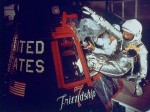This is the sharpest image ever taken of the Apollo 12 landing site.
One of the details that shows up is a bright L-shape in the Apollo 12 image. It marks the locations of cables running from ALSEP’s central station to two of its instruments. Although the cables are much too small for direct viewing, they show up because they reflect light very well.
The higher resolution of these images is possible because of adjustments made to LRO’s [Lunar Reconnaissance Orbiter], which is slightly oval-shaped or elliptical. “Without changing the average altitude, we made the orbit more elliptical, so the lowest part of the orbit is on the sunlit side of the moon,” said Goddard’s John Keller, deputy LRO project scientist. “This put LRO in a perfect position to take these new pictures of the surface.”
The maneuver lowered LRO from its usual altitude of approximately 31 miles (50 kilometers) to an altitude that dipped as low as nearly 13 miles (21 kilometers) as it passed over the moon’s surface. The spacecraft has remained in this orbit for 28 days, long enough for the moon to completely rotate.
Check out NASA’s page for more, including photos of the Apollo 14 and 17 landing sites.



